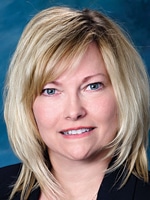December 2020—The Compass Group reconvenes to share the latest on SARS-CoV-2 testing—this time on Oct. 6 and again by Zoom. What they said about supplies, labor, and flu follows. Serology testing too: “It’s the one test we have loads of and the one test they don’t use a lot of,” said Heather Dawson of Allina Health in Minneapolis.
CAP TODAY publisher Bob McGonnagle led the roundtable. With Dawson were Walter Henricks, MD, of Cleveland Clinic; Jennifer Laudadio, MD, of the University of Arkansas for Medical Sciences; Joseph Baker of Baylor Scott & White; Judy Lyzak, MD, MBA, of Alverno; Susan Fuhrman, MD, of OhioHealth; Dan Ingemansen and Rochelle Odenbrett, MT(ASCP), MBA, of Sanford Health; Janet Durham, MD, of ACL Laboratories; Diana Kremitske, MS, MHA, MT(ASCP), of Geisinger; Darlene Cloutier, MSM, MT(ASCP), HP, of Baystate; Stan Schofield of NorDx; Clark Day of Indiana University Health; Tylis Chang, MD, of Northwell; and John Waugh, MS, MT(ASCP), of Henry Ford.
The Compass Group is an organization of not-for-profit IDN system lab leaders who collaborate to identify and share best practices and strategies.
Wally Henricks, what is the current state of play and what’s uppermost in your minds in the labs at Cleveland Clinic?
Walter Henricks, MD, medical director, Center for Pathology Informatics, Cleveland Clinic: We’ve ramped up capacity, we diversified our platform, we deployed Cepheid in our regional hospitals. We are not doing any antigen testing or serology testing. We are testing pre-procedure whether the patient is symptomatic or not, and we’re testing all patients who are symptomatic. We’re supporting community efforts with community fairs and through some of the state’s pop-up testing.
What is your supply of the Cepheid tests like? I’ve heard from people who are finding it difficult to get all the Cepheid tests they want.
Dr. Henricks (Cleveland Clinic): Yes, we would put ourselves in that category. Our allocation fluctuates and at times it’s constrained to the point that we have placed restrictions on what can be ordered.

Dr. Laudadio
Jennifer Laudadio, do you have the same supply chain problems others have experienced?
Jennifer Laudadio, MD, professor and chair, Department of Pathology, University of Arkansas for Medical Sciences College of Medicine: We don’t have a problem with instruments, but we are having a hard time getting cartridges for those instruments. We have a Cepheid platform, and we’re also using GenMark and the Roche 6800. None of those are being used to the capacity they could be. So we’re making up the difference with a laboratory-developed test, using the CDC primers and probes, and we haven’t had problems getting supplies for that.
The challenge continues to be viral transport media; we are making our own and also using sterile saline collection tubes. We had a challenge with pipette tips but not specifically COVID. It was a Roche pipette tip issue for our 4800, on which we run our CT/NGs, which used to be our highest-volume testing in the lab before COVID. Now we’re having to send out 1,000 CT/NGs every month in addition to the COVID tests.
What is your lab labor situation now in Little Rock?
Dr. Laudadio (UAMS): We are sending out some of our low-volume, more complex molecular tests so that our technologists can be dedicated to COVID testing. We brought back someone who was retired, and we have someone who used to be 50 percent now working 100 percent time. We’ve also created four new positions in our molecular lab.
Joe Baker, what is your situation like?

Baker
Joseph Baker, VP of laboratory, Baylor Scott & White Health, Dallas: It’s no different than what everyone else is experiencing. We have a plethora of equipment in our system—Roche, Hologic, Applied BioCode, others—because we can’t rely on any one vendor to meet all our testing needs. We have Cepheid and BioFire at many of our community hospitals for the pre-procedure and emergency work. We are doing antigen testing in some of our clinics. We are also using ID Now for the emergency discharges across the system. And we have a few sites that are using Luminex.
We have problems getting universal transport media. We’re using the saline tubes for the vast majority of our collections at this time. But that’s worrisome when we get into fall with flu testing. We’re using a ticket to test paper form in many of our hospital sites to prioritize what platforms the testing is performed on. We have Roche Liats at many of our sites, but we’re waiting for the combo test to get approval.
We currently have 83 openings within our system, and about 40 of those are MT and MLT positions.
Judy Lyzak, has the supply chain improved for you? Are you able to allocate tests and select patients for testing any better than in past months? Or is it still hectic every day?
Judy Lyzak, MD, MBA, VP of medical affairs, Alverno Laboratories, Indiana and Illinois: I don’t know if it’s any less hectic, but we’re much more used to it. The supply chain for ID Now kits is slightly better. That was one of our pain points. We had put in orders for a certain number of kits and we were getting a fraction of that week after week. We had to work with our clinicians at all of our hospitals to continually remind them what the criteria were to use that method. But we got through it and the supply has evened out in the past couple of weeks, which is critical for us because we just released our flu-COVID testing algorithm. And it’s very heavy for the EDs, irrespective of admission or not, on using ID Now testing to make decisions about what is the possible etiology of respiratory symptoms.
Susan Fuhrman, how are things in Columbus?
Susan Fuhrman, MD, president, CORPath, Department of Pathology and Laboratories, OhioHealth Riverside Methodist Hospital, Columbus: We are in a similar situation. We had real issues with supplies of our Abbott ID Now reagent. It was dreadfully nip and tuck, and we went into several weekends with barely enough reagent for predicted needs and all kinds of backup plans in case we ran out before the next shipment. The situation appears to have settled out.
In the meantime, we’re implementing the combo flu-COVID Liat tests at many of our sites, and we’re waiting for the Cepheid combo test to be FDA approved. We’re going to do the combo tests on our symptomatic influenza-like illness patients, which allows us to use only one swab on these patients in our emergency rooms at most of our sites. We’re going to test patients with two swabs—a flu and a COVID, using the Abbott ID Now—in the emergency rooms at our larger hospitals because of larger reagent allocations of the ID Now kits. So everyone who’s symptomatic with ILI is going to get a COVID and a flu test. The algorithm for this is complicated because it depends on the site where the patient is being seen. The Liat and Cepheid require specimens in viral transport media, and the Abbott ID Now is a dry swab, so we need to have the computer system to indicate the correct swab to collect for the order.
We’re going to roll out the Abbott ID Now to all of our urgent cares to be performed on site. We couldn’t do that until we knew we reliably had Abbott ID Now reagent. The urgent cares were flip-flopping—using dry nasal swabs on the Abbott until we ran low on Abbott reagent, then we had to switch them to viral transport media and do PCR. Then we had issues with the pipette tip shortages for our PCR assays and had to switch them back to the dry swabs. It’s pretty much a nightmare.
What is your labor situation now?
Dr. Fuhrman (OhioHealth): We’re constrained by reliable supply availability, particularly with the Abbott ID Now reagents. The ID Now used for any kind of high-volume situation requires a lot of labor, which is also in short supply.
To meet these demands, we’re implementing Thermo Fisher QuantStudios in a brand-new molecular lab with automated liquid handlers and processing equipment. That’s a big labor savings because we can automate some of the higher-volume testing that we’re doing manually now on the Abbott ID Now. Since the Abbott ID Now can only do one specimen at a time, this constrains the total number of tests that can be performed by each tech using this testing platform in a high-volume location.
Dan Ingemansen, what’s going on in South Dakota? You had a low rate and now you’re almost leading the league tables.
Dan Ingemansen, senior director, laboratory, Sanford Health, Sioux Falls, SD: South Dakota has had the fewest restrictions of all the states. But just as the other Compass Group members have done, we started early and we diversified. We now have five different methods, and supplies are limited but have yet to run out. We divide our testing pathway into two categories, rapid and batch testing. For rapid testing, we, like others, are receiving Cepheid cartridges, and we are focusing those supplies to our hospitals for our inpatients and emergency patients only. Anything coming from an outpatient setting going through the hospital is not being routed to a Cepheid; we have had to supplement some of our Cepheid usage with the DiaSorin instruments. But it’s not a great rapid solution because it’s a 90-minute test. On the batched side, Sanford Laboratories does not have a Hologic Panther or a Roche 6800/8800. We started with a single Abbott m2000 that is exhausted—we were running it 24/7. In addition, we added a PerkinElmer solution, including a Chemagic 360 extractor, and several Applied Biosystems 7500 thermocyclers.
Our most recent investment has been two Abbott Alinitys, and we’ve had good luck getting the supplies to keep those analyzers humming at 600 to 800 tests per day.
Despite the diversification, we still can’t keep up with the demands.
Heather Dawson, are you seeing greater clarity on or understanding of the usefulness of the serology tests?
Heather Dawson, VP of laboratory services, Allina Health, Minneapolis: We haven’t spent a lot of time on the serology. It is up and running with limited usage. The clinical team on the ambulatory side put together the indications for when it would be appropriate and they adhere to their own guidelines, and we see very little of it. It’s the one test we have loads of and the one test they don’t use a lot of. What’s different since our last call [on Sept. 1] is we now have equipment coming: We’re standing up T2 Biosystems in all of our smaller community hospitals and bringing in Seegene to the central laboratory.
What is your labor situation at Allina?
Heather Dawson (Allina): It’s as tight as everybody else’s. A lot of people working a lot of overtime. We have about 40 openings across the system now between the ambulatory division and some of our smaller hospitals. We have a batch of students starting soon and we hope to hire them as soon as they graduate.
Janet Durham, what is your experience at ACL?
Janet Durham, MD, medical director, Wisconsin operations, ACL Laboratories, and president, Great Lakes Pathologists, West Allis, Wis.: It’s similar to that of the others. Diversification is how we’re staying up on the testing requirements. We have a lot of instruments for which we don’t have enough reagent. We’re using Hologic Panthers and Cepheid in the hospitals and ED, and we started antigen testing at urgent care facilities. Now we have some send-out tests also. But the biggest recent change is that we started pooling in the low-prevalence population on the Hologic Panthers, and that has helped the reagent shortage problem. It’s been a cost savings.
Diana Kremitske, I assume your experience at Geisinger is similar, but is there a new wrinkle you can share with the group?

Kremitske
 CAP TODAY Pathology/Laboratory Medicine/Laboratory Management
CAP TODAY Pathology/Laboratory Medicine/Laboratory Management
